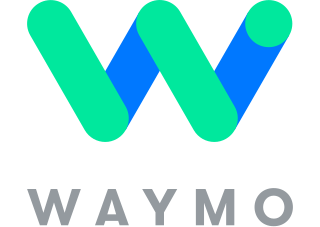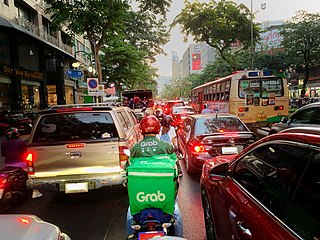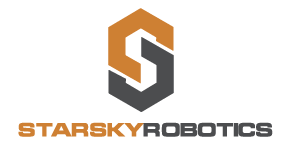
A self-driving car, also known as an autonomous car, driverless car, or robotic car (robo-car), is a car that is capable of traveling without human input. Self-driving cars use sensors to perceive their surroundings, such as optical and thermographic cameras, radar, lidar, ultrasound/sonar, GPS, odometry and inertial measurement units. Control systems interpret sensory information to create a three-dimensional model of the vehicle's surroundings. Based on the model, the car then identifies an appropriate navigation path and strategies for managing traffic controls and obstacles.

Uber Technologies, Inc is an American transportation conglomerate that mainly provides taxi services where individuals can hail a taxi (Uber) in an app on their phone. The company, based in San Francisco, provides additional services of ride-hailing, food delivery, package delivery and freight transport in the United States and around the world.

Vehicular automation involves the use of mechatronics, artificial intelligence, and multi-agent systems to assist the operator of a vehicle. These features and the vehicles employing them may be labeled as intelligent or smart. A vehicle using automation for difficult tasks, especially navigation, to ease but not entirely replace human input, may be referred to as semi-autonomous, whereas a vehicle relying solely on automation is called robotic or autonomous.

Waymo LLC, formerly known as the Google Self-Driving Car Project, is an American autonomous driving technology company headquartered in Mountain View, California. It is a subsidiary of Alphabet Inc., the parent company of Google.

Experiments have been conducted on self-driving cars since 1939; promising trials took place in the 1950s and work has proceeded since then. The first self-sufficient and truly autonomous cars appeared in the 1980s, with Carnegie Mellon University's Navlab and ALV projects in 1984 and Mercedes-Benz and Bundeswehr University Munich's Eureka Prometheus Project in 1987. Since then, numerous major companies and research organizations have developed working autonomous vehicles including Mercedes-Benz, General Motors, Continental Automotive Systems, Autoliv Inc., Bosch, Nissan, Toyota, Audi, Volvo, Vislab from University of Parma, Oxford University and Google. In July 2013, Vislab demonstrated BRAiVE, a vehicle that moved autonomously on a mixed traffic route open to public traffic.

Grab Holdings Inc. is a multinational technology company headquartered in One-north, Singapore. It is the developer of a super-app for transportation, food delivery and digital payments services on mobile devices that operates in Singapore, Malaysia, Cambodia, Indonesia, Myanmar, the Philippines, Thailand and Vietnam.
A robotaxi, also known as robo-taxi, self-driving taxi or driverless taxi, is an autonomous car operated for a ridesharing company.
This is a timeline of Uber, which offers a variety of transportation and logistics services and is an early example of the rise of the sharing economy.

Trucker Path is an American transportation network company specializing in online and mobile services for the trucking industry. In early 2013, the company released its trip planning and resource locating mobile app Trucker Path. In mid-2015, it was followed by Truckloads, a marketplace available on the web and mobile devices specializing in connecting freight companies with carriers. By March 2015 the Trucker Path app had 100,000 users. One year later, Trucker Path reached one million downloads on iOS and Android combined. By June 2016, the number of active monthly users surpassed 450,000, which represented 30% of all Class 8 truckers in the U.S. Truckloads became the most installed freight-matching mobile app with over 250,000 installs by the end of 2016. In February 2017, Trucker Path reached over 1.5 million total installs and is the first in the trucking industry to have over one million installs on the Google Play Store. In December 2017, Renren announced that it acquired Trucker Path.

Didi Chuxing Technology Co., formerly named Didi Dache (嘀嘀打车) and Didi Kuaidi, is a Chinese vehicle for hire company headquartered in Beijing with over 550 million users and tens of millions of drivers. The company provides app-based transportation services, including taxi hailing, private car hailing, social ride-sharing, and bike sharing; on-demand delivery services; and automobile services, including sales, leasing, financing, maintenance, fleet operation, electric vehicle charging, and co-development of vehicles with automakers. The company is a subsidiary of Xiaoju Kuaizhi Inc.

Yandex Taxi is an international company owned by Russian IT-giant Yandex and that operates taxi aggregation and food tech businesses across Russia, CIS, Eastern Europe, Africa and the Middle East. The company is among the world's leading developers of self-driving technology.
Ottomotto LLC, d/b/a Otto, was an American self-driving technology company founded in January 2016 by Lior Ron and Anthony Levandowski.

Anthony Levandowski is a French-American self-driving car engineer. In 2009, Levandowski co-founded Google's self-driving car program, now known as Waymo, and was a technical lead until 2016. In 2016, he co-founded and sold Otto, an autonomous trucking company, to Uber Technologies. In 2018, he co-founded the autonomous trucking company Pronto; the first self-driving technology company to complete a cross-country drive in an autonomous vehicle in October 2018. At the 2019 AV Summit hosted by The Information, Levandowski remarked that a fundamental breakthrough in artificial intelligence is needed to move autonomous vehicle technology forward.

Argo AI was an autonomous driving technology company headquartered in Pittsburgh, Pennsylvania. The company was co-founded in 2016 by Bryan Salesky and Peter Rander, veterans of the Google and Uber automated driving programs. Argo AI was an independent company that built software, hardware, maps, and cloud-support infrastructure to power self-driving vehicles. Argo was mostly backed by Ford Motor Co. (2017) and the Volkswagen Group (2020).
Einride AB is a Swedish transport company based in Stockholm, Sweden, specializing in electric and self-driving vehicles known as Einride pods. The pods are electric trucks remotely controlled by drivers, and are notable for their lack of a driver’s cab.

Starsky Robotics was an autonomous truck company founded in 2016. It developed trucks to drive without a person in the vehicle. The company started in 2015 and had raised $21.7 million by 2018. It failed to find further investors in November 2019, and shut down by March 2020.

A self-driving truck, also known as an autonomous truck or robo-truck, is an application of self-driving technology aiming to create trucks that can operate without human input. Alongside light, medium, and heavy-duty trucks, many companies are developing self-driving technology in semi trucks to automate highway driving in the delivery process.
Drive.ai, a subsidiary of Apple Inc., is an American technology company headquartered in Mountain View, California that uses artificial intelligence to make self-driving systems for cars. It has demonstrated a vehicle driving autonomously with a safety driver only in the passenger seat. To date, the company has raised approximately $77 million in funding. Drive.ai's technology can be modified to turn a vehicle autonomous.
Aurora Innovation, Inc., doing business as Aurora, is a self-driving vehicle technology company based in Pittsburgh, Pennsylvania. Aurora has developed the Aurora Driver, a computer system that can be integrated into cars for autonomous driving. Aurora was co-founded by Chris Urmson, the former chief technology officer of Google/Alphabet Inc.'s self-driving team, which became known as Waymo, as well as by Sterling Anderson, former head of Tesla Autopilot, and Drew Bagnell, former head of Uber's autonomy and perception team.













